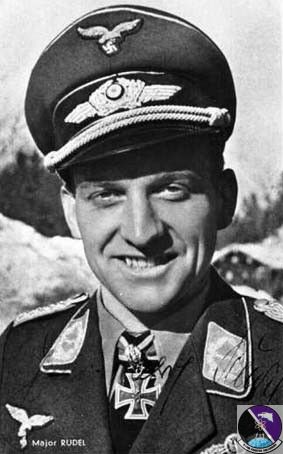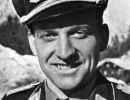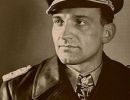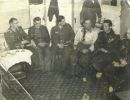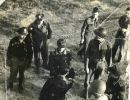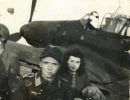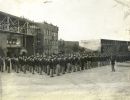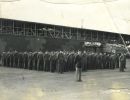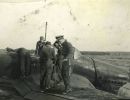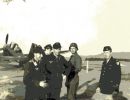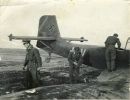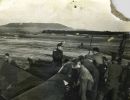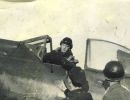Rudel flew 2,530 combat missions claiming a total of 2,000 targets destroyed; including 800 vehicles, 519 tanks, 150 artillery pieces, 70 landing craft, nine aircraft, 4 armored trains, several bridges, a destroyer, two cruisers, and the Soviet battleship Marat.
Oberst Hans-Ulrich Rudel, Kommodore of Schlachtgeschwader 2, surrendered himself to the Allied Forces at Kitzingen on 8 May 1945, the final day of the war in Europe. The surrender is quite relevent to the FW 190, because accompanying Rudel's Ju 87 G-2 - along with some other Ju 87s - were a number of FW 190s.
On 8 May 1945, Kitzingen airfield in Germany was home to the Republic P-47s of the 405th FG, but before the day was out, it was also to be the home of a number of Luftwaffe Ju 87s and FW 190s. Oberst Hans-Ulrich Rudel's Schlachtgeschwader 2 had continued to support German ground forces in the east until the final days of the war, but with hostilities to cease on 8 May 1945, and facing capture by the Russians, Oberst Rudel and his unit decided to try to reach the West.
Stab and II./S.G. 2 were based at Kummer, in northern Bohemia, I./S.G. 2 was in Austria, and III./S.G. 2 was near Prague. The I. and III.Gruppe both escaped westwards. Although the Stab and II./S.G. 2 had few serviceable aircraft, it was decided to fly as many men out as possible, while a vehicle convoy would try to reach the west with the rest of the unit's personnel. This ground column was later attacked and destroyed, with few survivors.[1] But this was in the future when Rudel led the three Ju 87s and four FW 190s westwards in the afternoon of 8 May. The unit made radio contact with the US XIX Tactical Air Command, and was directed to the airfield at Kitzingen. Allied anti-aircraft defenses were made aware of the approach of the aircraft.[2]
During the two-hour flight, S.G. 2 had encountered Soviet aircraft, but had escaped unharmed, aand arrived at Kitzingen late in the afternoon. After circling the airfield, the seven German aircraft landed to surrender, quickly being surrounded by their excited captors. A total of seven aircraft landed, and they carried six officers, six NCOs, and one civilian female.
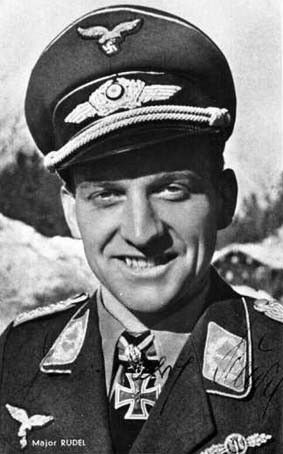
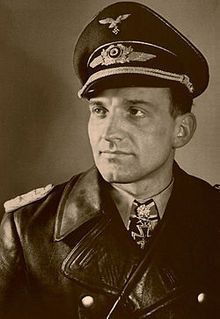

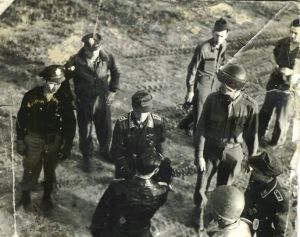
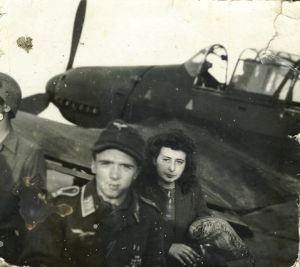
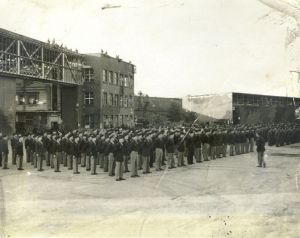
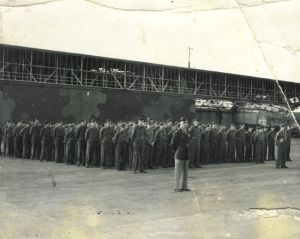
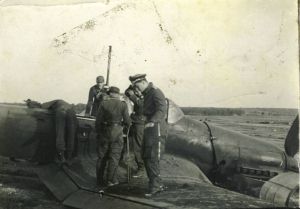
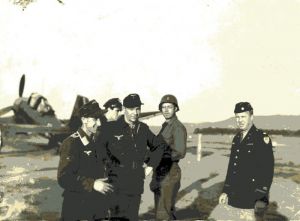
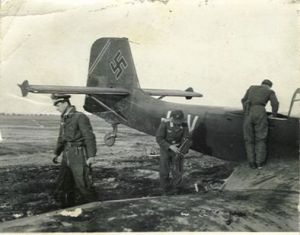
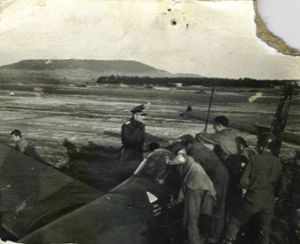
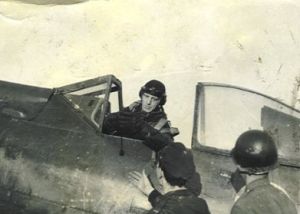
Known personnel included:
Oberst Hans-Ulrich Rudel - Kommodore S.G. 2, RK mit Gold EL, nine aerial victories, 2,530 operational flights.
Oblt. Karl Bierman - Staffelkapitän 5./S.G. 2.
Oblt. Hans Schwirblat - Staffelkapitän 10.(Pz.)/S.G. 2, RK.
Major Kurt Lau - Kommandeur II./S.G. 103, RK.
Hptm. Ernst-August Niermann - war correspondent and pilot, DKiG.
Major Karl Kennel - Kommandeur II./S.G. 2, RK mit EL, 34 aerial victories, 957 operational flights.
At least three aircraft were deliberately damaged on landing, with Rudel - who was first to land - smashing the undercarriage and the propeller blades of his Ju 87 G-2. Oblt. Schwirblatt crashed his Ju 87 D-5, and another aircraft deliberately damaged was the FW 190 A-8 of Major Karl Kennel. Kennel wrecked the right wing and sheared off the undercarriage in a crash-landing. Other aircraft could not be damaged because they carried passengers.
One of the Ju 87s, piloted by a Feldwebel, was carrying a female passenger (probably the pilot's girlfriend). This aircraft taxied up to the reviewing stand at the airfield, where "Stuka Girl" disembarked. A third Ju 87 landed just after "Stuka Girl's" aircraft. One of the FW 190s carried a passenger in the usual position for an evacuation, stuffed in the radio compartment - a very tight fit!
The pilots of these aircraft had achieved their objective of avoiding Soviet captivity, but some Luftwaffe pilots and ground crew were not as lucky, having to endure years of isolation from their homeland, trapped in Soviet Prisoner of War camps.
Appendix I: Aircraft surrendered at Kitzingen in the late afternoon of 8 May 1945
| Type | Markings | W.Nr | Unit | Crew |
| Ju 87 G-2 | 'Black <- + -' | 494 110 | Stab S.G. 2 | Oberst Hans-Ulrich Rudel; Hptm. Ernst-August Niermann |
| Ju 87 D-5 | 'T6 + VU' | ? | 10.(Pz.)/S.G. 2 | Oblt. Hans Schwirblat |
| Ju 87 D-5 | 'T6 + TU' | ? | 10.(Pz.)/S.G. 2 | Ofw. ?; Fw. ?; female passenger |
| FW 190 A-8 | 'Black << + -' | 171 189 | Stab II./S.G. 2 | Major Karl Kennel |
| FW 190 A-6 | 'White 2 + -' | 550 503 | 4./S.G. 2 | ? |
| FW 190 F-8 | 'White 9 + -' | 585 584 | 4./S.G. 2 | ? |
| FW 190 F-8 | 'White 12 + -' | 583 234 | 4./S.G. 2 | ? |
Other Aircraft Reported to have been Involved
| FW 190 A/F | 'Black 5 + -' | ? | II./S.G. 103 | Hptm. Kurt Lau |
Ju 87 G-2 W.Nr 494 110 'Black <- + -' Stab S.G. 2
The camouflage scheme of Rudel's aircraft, according to B.C. Rosch (ed.) Luftwaffe Verband #21, January 2000, p.1, was a "patched and well-worn" RLM 70 black-green / RLM 71 dark green splinter scheme. The Geschwaderkommodore markings were black with a thin white outline. The Balkenkreuz and Hakenkreuz were the late-war white outline type, and the six-digit W.Nr was in black above the Hakenkreuz. The spinner was RLM 70 black-green with a white spiral, and the rudder had the two white diagonal stripes seen on a number of S.G. 2 aircraft.
Ju 87 G-2 W.Nr 494 013 '< + -' of Stab S.G. 2 suffered a belly-landing at Fl.Pl. Niemes-Süd on 18 April 1945, sustaining 25% damage. Perhaps 494 110 was a replacement machine.
Ju 87 D-5 W.Nr unknown 'T6 + TU' 10.(Pz.)/S.G. 2
This aircraft carried a female passenger, and had the yellow V marking under the right wing (for further details on this marking, go to this page). On the rudder were the two white diagonal stripes.
Ju 87 D-5 W.Nr unknown 'T6 + VU' 10.(Pz.)/S.G. 2
Flown by Oblt. Schwirblatt, this aircraft also carried the two white diagonal stripes on the rudder.
FW 190 A-8 W.Nr 171 189 'Black << + -' Stab II./S.G. 2
The aircraft of Karl Kennel, this FW 190 A-8 was built in July 1944 by the Focke-Wulf factory at Cottbus. The undercarriage fairings were oversprayed with one of the upper surface colours. To view a photo of a data plate that is almost certainly from this aircraft, please go to this page.
FW 190 A-6 W.Nr 550 503 'White 2 + -' 4./S.G. 2
W.Nr 550 503 was an Ago-built aircraft, completed in August 1943
FW 190 F-8 W.Nr 584 584 'White 9 + -' 4./S.G. 2
An FW 190 Jabo built by Arado at Warnemünde, this ircraft had the bulged canopy of later FW 190s. After capture, it was painted with the star and bars, and the 509th FS code of 'G9 - T' was applied. It retained the Hakenkreuz, and was probably flown only once by Lt. Oscar Theis, a Texan.
FW 190 F-8 W.Nr 583 234 'White 12 + -' 4./S.G. 2
This aircraft was an FW 190 F-8, not as previously reported, an FW 190 A-8. It was also built by Arado at Warnemünde. In American hands, this aircraft recieved the 511th FS code of 'K4 -', but was probably not flown.


